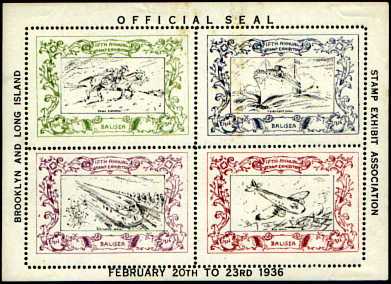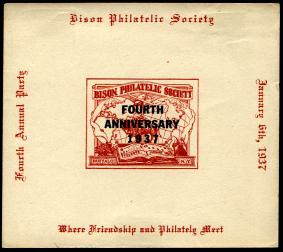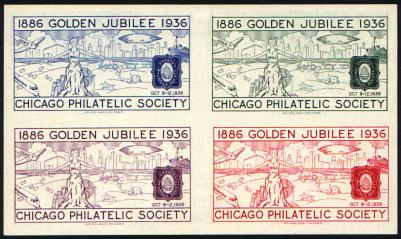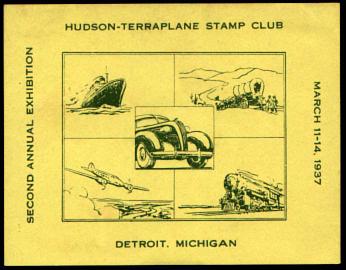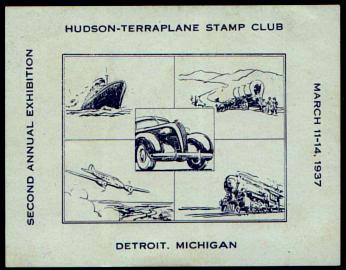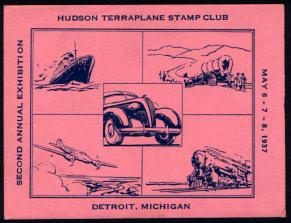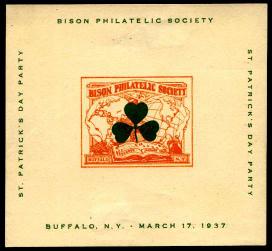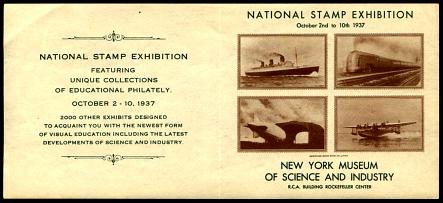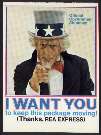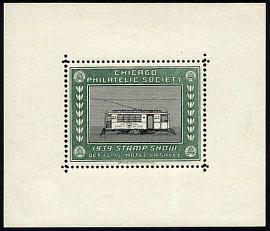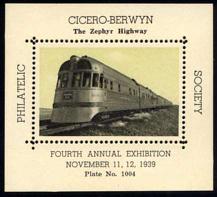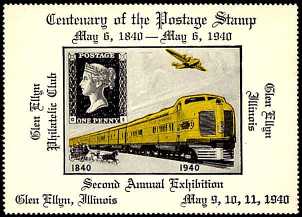

Trains on Philatelic Exhibition Seals
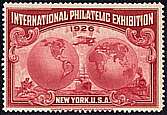 |
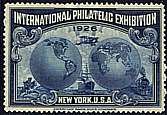 |
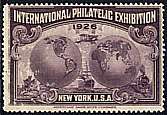 |
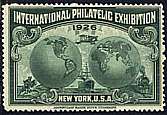 |
Many collectors love to show off their collections, and Philatelic Exhibitions are where stamp collectors display theirs. Such shows range in size from small ones that fit in a small town meeting hall, up to huge ones that fill giant convention centers, and they always include, in addition to the collector exhibits after which they are named, a dealer bourse, with stands or tables selling material from stamp dealers and postal authorities. There are at least two yearly philatelic exhibitions here in Walnut Creek, even though the population is only about 65,000, and the shows themselves fit into a hall about 40 feet square, and consist of fewer than a hundred frames and about twenty dealer tables plus a table manned by personnel from the local Post Office. Westpex , the yearly regional stamp show in San Francisco, thirty miles west of here, is much larger, with 60 to 80 dealers, and three hundred exhibit frames, though sadly the USPS failed to show the past few years - budget cuts have been closing their philatelic outreach efforts. Pacific 97, the last huge international expo in the U.S., filled both halls of Moscone Convention Center in San Francisco.
Most such exhibitions of medium size or larger issue souvenir labels called Philatelic Exhibition Seals. These are Cinderellas, of course, but many stamp collectors still love them. The earliest one I know of was issued in 1902, and thousands more have been produced over the almost hundred years since.
In tribute to the importance of trains in moving the mail, many philatelic expo seals depict a train or locomotive, and since trains are my favorite stamp topic, I have accumulated all the philatelic expo seals with a train that I could find. The set at the top of this page are the earliest with a train that I know of, produced in 1926. Below are some more of my favorites. I have organized them chronologically, because that's the way that appeals to me, but a better way from a cataloging purpose would be by the organization that issued the seal. Two fellow collectors of Philatelic Expo seals produced such a catalog, and Roger Riga has made it available on the web - the Fields-Picklo catalog of Philatelic Exhibition seals, at HERE. It is sorted only by issuer, whereas I would like a sort by date as well, and of course in ideal form it would include illustrations of all the entries, but it's an excellent resource, nonetheless.
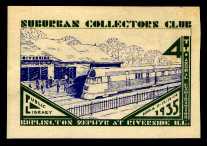 |
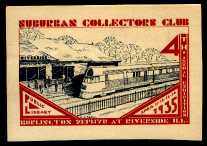 |
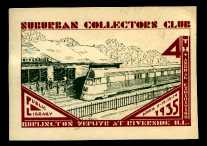 |
 |
Recently I saw just the train stamp from the sheetlet above, in rather poor condition, offered at the APS Stamp Store for $8, and listed as a cinderella of Great Britain! I would consider $8 a reasonable price for the entire sheet, in good condition. I presume the owner, clueless about the meaning of "BALISEA", guessed it must be a town in the British Isles. (By the way, I recommend the APS Stamp Store as an excellent source of stamps and Cinderellas. I remember with amusement the dire prognostications of some would-be luminaries for its future when the APS announced plans to create it, and I note that it has grown steadily in size and volume of sales from Day 1. If you do not belong to the APS, join and check out this site! But keep in mind that the APS does not write or review the descriptions - they are the product - often fanciful - of the owners of the material, and should be treated with the same critical consideration you would give an item someplace like eBay.)
On some of these the train is hard to find, but I assure you, it's there!
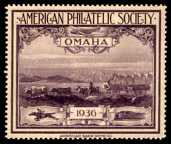 |
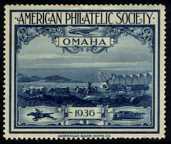 |
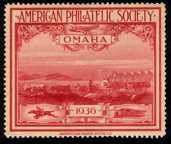 |
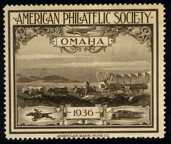 |
You may be starting to catch on by now that these seals are often produced in sets of four, with the same design and different colors. Up until 1950 or so many, especially those for large national and international shows, were of very high quality - elaborate designs produced by major printing companies such as the American Bank Note Company, and printed from engravings.
 |
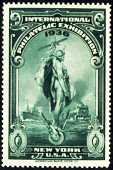 |
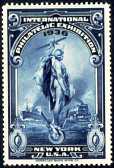 |
 |
The set above is another favorite of mine, mainly for the exceptional quality of its design and printing. The design is typical of the genre, in that it depicts the transportation modes used in carrying the mail throughout history - that's Mercury (or, if you prefer, Hermes), messenger of the gods, in the center, flanked by a modern steamship on one side, and a steam locomotive on the other.
Note that this is the same design used the prior year -
Once you have a design you like, why not keep using it?
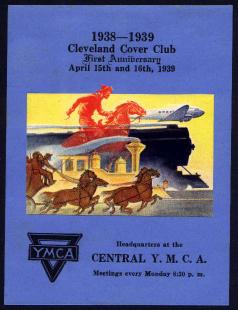 |
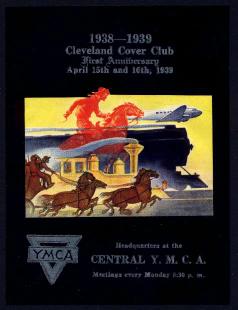 |
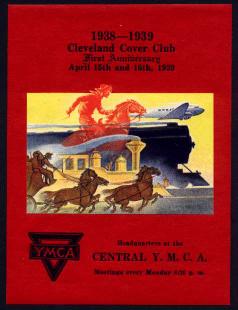 |
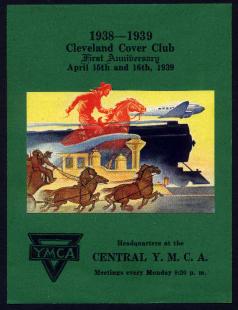 |
What you probably cannot tell from my scans of the seals above is that the multicolor image in the center is not printed on the background paper - it is a separate, die- cut seal, glued on at the top - here's how that looks by itself. This image was a created by the Railway Express Agency (A forerunner of today's FexEx and UPS) as part of their ad campaign for the SF and NY World's Fairs of 1939. I have it on postcards and a Railway Express advertising label. In fact, it looks to me like the label on the seals above was cut from the advertising label! I wonder how that came about - I suspect a member of the Cleveland Cover Club was also an executive of Railway Express.
The text on the back of the postcards reads
This dramatic painting by a famous artist pictures the 100 colorful years of express service. It contrasts yesterday's romantic Pony Express, the rumbling Overland Stage and quaint "Iron Horse" with today's mighty express trains and super-swift planes that carry the goods of the nation from coast to coast, border to border. Today RAILWAY EXPRESS has more than 57,000 employees, 11,300 motor vehicles, and 23,000 nation- wide offices, with pick-up and delivery services in all cities and principal towns.
Here's one final item, not a Philatelic Exhibition Seal, but related to REA, a patriotic label they issued during WW II:
When I was a child, the green trucks of REA were a common sight, but today I doubt anyone under forty has even heard the company's name. What ever happened to them? Another casualty of progress.
Chicago has always been one of the major U.S. centers of philately (some would say
the center), and during the 1930's and 1940's Henry Grimsland, a talented and
prolific FDC cachet artist, was a resident
of the area, and produced a series of Philatelic Exhibition seals for clubs in the area,
including the one above.
Click here to view a few more. They
appear to be engraved, presumably by hand.
The 1930's were the Golden Age for Philatelic Exhibition Seals - many were produced then, and they were of highest quality. The ones since are mostly poorly designed and cheaply produced, though there have been exceptions.
 |
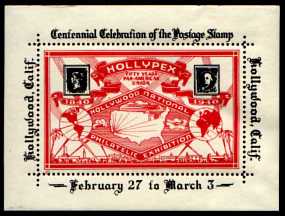 |
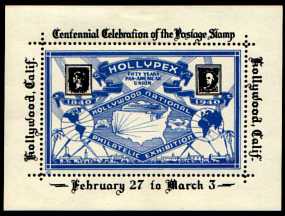 |
 |
That's what I have through 1940 - more to follow as I get time.
Send feedback to the webmaster: CLICK HERE
Revised -- 01/23/2003
